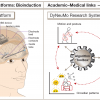Related Factors and Outcome of Spinal Cord Stimulation Electrode Deviation in Disorders of Consciousness.
Spinal cord stimulation (SCS) has been reported to be a promising neuromodulation method for patients with disorders of consciousness (DOC). Our previous studies found that clinical characteristics of patients and SCS stimulation parameters could affect the therapeutic effects of SCS, while surgical-related factors remain unknown. Through the improvement of surgical procedures, most of the SCS electrodes are implanted in the middle, while a small number of electrodes have still deviated.
A total of 137 patients received SCS treatment in our institutions from 1 January 2010 to 31 December 2020. Among them, 27 patients were found with electrode deviation and met the inclusion criteria. Patients were grouped according to whether the electrode deviation angle (EDA) is >30°, respectively. Clinical characteristics of patients and SCS stimulation parameters were compared. Potential related factors and outcomes were evaluated by Chi-square test or two-way repeated measures analysis.
Twenty seven patients receiving cervical SCS treatment were found to have electrode deviation postoperatively. Among them, 12 patients were classified into the more deviation group. No significant difference was found among age, sex, pathogeny, course of DOC, C2-C5 distance, spinal cord to spinal canal ratio at C2 level, and preoperative JFK Coma Recovery Scale-Revised (CRS-R) scores. We found that the electrode direction significantly deviated to the contralateral side in the lateral decubitus position ( = 0.025). The maximum tolerant stimulation intensity in the less deviation group (1.70 ± 0.41) was significantly higher than that in the more deviation group (1.25 ± 0.34) ( = 0.006). Under the strongest stimulation, less unilateral limb tremor ( = 0.049) and paroxysmal sympathetic hyperactivity (PSH) episodes ( = 0.030) were found. EDA had a significant effect on postoperative CRS-R in patients, and patients in the less deviation group had significantly higher postoperative CRS-R ( < 0.01). There was also an interaction effect between EDA and postoperative time. With the prolonged postoperative time, the CRS-R improvement rate of patients with different EDA was different, and the CRS-R improved faster in patients with less EDA ( < 0.05).
Electrode deviation will affect the outcome of patients receiving cervical SCS treatment. The intraoperative surgical position is associated with postoperative electrode deviation direction. The reduction of EDA under 30° can increase maximum tolerant stimulation intensity, reduce complications, and further improve patients' outcomes.
2022. Front Neurol, 13:947464.
2017.Mov. Disord., 32(6):810-819.
2023. NPJ Parkinsons Dis, 9(1):93.
